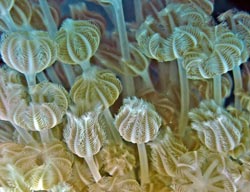Does the future of reefs belong to pulsating soft corals?

Xeniid soft corals in the Red Sea<br>Photo: M. Naumann, ZMT <br>
The feathery polyp tentacles of the xeniid soft corals open and shut like birds’ wings. These soft corals make pulsating movements – a rarity among sessile sea organisms. For a long time it was not known what purpose this continuous pulsation activity served – since it costs a lot of energy!
Recently, an Israeli research team of the University of Jerusalem published striking findings on this pulsating movement in the journal PNAS (Proceedings of the National Academy of Sciences USA). Reef ecologists of the Leibniz Center for Tropical Marine Ecology – ZMT have now commented on these findings in PNAS, placing them in a broader ecological context. They come to a surprising prognosis on how tropical coral reefs may develop in the future.
The Israeli researchers describe two main benefits of the pulsating movement for xeniid soft corals. With the aid of their symbiotic algae these tropical corals perform photosynthesis to gain energy. Here, oxygen is produced, which through the pulsating movement is effectively transported out of the coral tissue, where oxygen enrichment would inhibit the CO2 fixation. The movements also help ensure that nutrients in the water are better distributed to all polyps. According to calculations made by the Israeli researchers, the energy investment for the pulsating movement amounts to a maximum of 56% of the gained energy. That is an economically sound deal.
For comparison, the Bremen reef ecologists Christian Wild and Malik Naumann examined two additional organisms that likewise live on the seabed of coral reefs and also exhibit body movements: the pumping mangrove jellyfish Cassiopea and the contracting unicellular ciliate colony of the genus Zoothamnium. All of these have in common the symbiosis with microorganisms. The researchers came to the conclusion that the active body movements of all three organisms generate considerable advantages for their metabolism and food supply – and ultimately probably affect growth positively.
Yet, another effect of pulsation could be of great importance; during photosynthesis, reactive oxygen radicals are also produced, which are very harmful for the metabolism of the corals. In the course of ocean warming, oxygen radicals induce corals to release their symbiotic algae, in turn causing the corals to bleach and often to die. Through pulsation, the radicals are probably transported away effectively. The Bremen researchers consider it very likely that pulsating soft corals are therefore particularly resistant to coral bleaching.
Such robustness and the favourable energy balance create a significant competitive advantage for soft corals in the reef. “Worldwide, you can now often see that there is a transition in coral reefs from stony corals, which were once dominant, to soft corals,” said Christian Wild. “However, stony corals are important ecosystem engineers, which regulate the functioning of the entire reef via the production of limestone structures and the release of organic substances such as carbohydrates and mucus.” The Bremen researchers suggest that material cycles in the reef could shift significantly, with negative consequences for the valuable characteristics of coral reefs.
Published in:
Wild C., Naumann M.S. (2013) Effect of active water movement on energy and nutrient acquisition in coral reef-associated benthic organisms. Proceedings of the National Academy of Sciences USA
Contact:
Prof. Dr. Christian Wild
Leibniz Center for Tropical Marine Ecology
Tel: 0421 / 23800 – 114
Mail: christian.wildzmt-bremen.de
Dr. Malik Naumann
Leibniz Center for Tropical Marine Ecology
Tel: 0421 / 23800 – 119
Mail: malik.naumannzmt-bremen.de
Media Contact
More Information:
http://www.zmt-bremen.deAll latest news from the category: Ecology, The Environment and Conservation
This complex theme deals primarily with interactions between organisms and the environmental factors that impact them, but to a greater extent between individual inanimate environmental factors.
innovations-report offers informative reports and articles on topics such as climate protection, landscape conservation, ecological systems, wildlife and nature parks and ecosystem efficiency and balance.
Newest articles

First-of-its-kind study uses remote sensing to monitor plastic debris in rivers and lakes
Remote sensing creates a cost-effective solution to monitoring plastic pollution. A first-of-its-kind study from researchers at the University of Minnesota Twin Cities shows how remote sensing can help monitor and…

Laser-based artificial neuron mimics nerve cell functions at lightning speed
With a processing speed a billion times faster than nature, chip-based laser neuron could help advance AI tasks such as pattern recognition and sequence prediction. Researchers have developed a laser-based…

Optimising the processing of plastic waste
Just one look in the yellow bin reveals a colourful jumble of different types of plastic. However, the purer and more uniform plastic waste is, the easier it is to…



